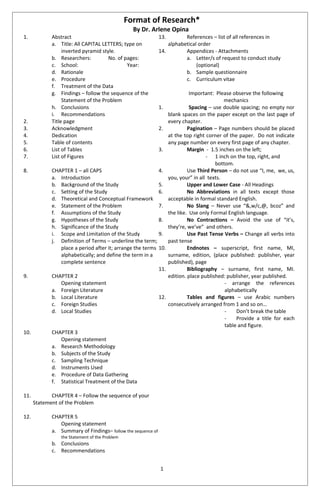
Format research
- 1. Format of Research* By Dr. Arlene Opina 1. Abstract 13. References – list of all references in a. Title: All CAPITAL LETTERS; type on alphabetical order inverted pyramid style. 14. Appendices - Attachments b. Researchers: No. of pages: a. Letter/s of request to conduct study c. School: Year: (optional) d. Rationale b. Sample questionnaire e. Procedure c. Curriculum vitae f. Treatment of the Data g. Findings – follow the sequence of the Important: Please observe the following Statement of the Problem mechanics h. Conclusions 1. Spacing – use double spacing; no empty nor i. Recommendations blank spaces on the paper except on the last page of 2. Title page every chapter. 3. Acknowledgment 2. Pagination – Page numbers should be placed 4. Dedication at the top right corner of the paper. Do not indicate 5. Table of contents any page number on every first page of any chapter. 6. List of Tables 3. Margin - 1.5 inches on the left; 7. List of Figures - 1 inch on the top, right, and bottom. 8. CHAPTER 1 – all CAPS 4. Use Third Person – do not use “I, me, we, us, a. Introduction you, your” in all texts. b. Background of the Study 5. Upper and Lower Case - All Headings c. Setting of the Study 6. No Abbreviations in all texts except those d. Theoretical and Conceptual Framework acceptable in formal standard English. e. Statement of the Problem 7. No Slang – Never use “&,w/c,@, bcoz” and f. Assumptions of the Study the like. Use only Formal English language. g. Hypotheses of the Study 8. No Contractions – Avoid the use of “it’s, h. Significance of the Study they’re, we’ve” and others. i. Scope and Limitation of the Study 9. Use Past Tense Verbs – Change all verbs into j. Definition of Terms – underline the term; past tense place a period after it; arrange the terms 10. Endnotes – superscript, first name, MI, alphabetically; and define the term in a surname, edition, (place published: publisher, year complete sentence published), page 11. Bibliography – surname, first name, MI. 9. CHAPTER 2 edition. place published: publisher, year published. Opening statement - arrange the references a. Foreign Literature alphabetically b. Local Literature 12. Tables and figures – use Arabic numbers c. Foreign Studies consecutively arranged from 1 and so on… d. Local Studies - Don’t break the table - Provide a title for each table and figure. 10. CHAPTER 3 Opening statement a. Research Methodology b. Subjects of the Study c. Sampling Technique d. Instruments Used e. Procedure of Data Gathering f. Statistical Treatment of the Data 11. CHAPTER 4 – Follow the sequence of your Statement of the Problem 12. CHAPTER 5 Opening statement a. Summary of Findings– follow the sequence of the Statement of the Problem b. Conclusions c. Recommendations 1
- 2. 13. All Table numbers and caption should be placed above the table Ex. see sample below Table 3 Gender of the Respondents 14. All figure numbers and caption should be placed below the figure/diagram. Numbers should be consecutively arranged as in 1,2,3, and so on… not 1.1, 1.2, 1.3, etc, Ex. see sample below 100 80 60 Grades 40 20 0 MALE FEMALE Figure 3 Grades of Respondents 15. Summary of Findings – Summary of Chapter 4. Same sequence with Statement of the Problem. 16. Conclusions – Opening Statement - Should not be the same with findings. - Findings are specific; while conclusions are general. - Number each conclusion as in: 1. 2. 3. 17. Recommendations – Opening Statement - Should be based on each conclusion. - Number each recommendation. 18. PREPARE FOR ORAL DEFENSE: PowerPoint presentation NOTE: _________________________________ *Every university has its own institutional format for students to follow. It is advisable that you adopt a similar format to achieve uniformity of style. As such, this format is recommended.
